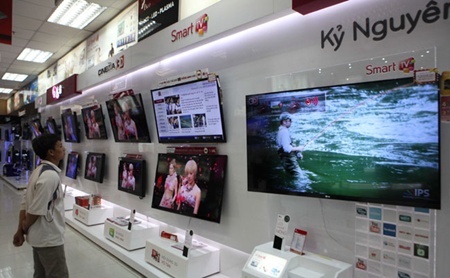Manufacturing continues to rise
 |
| A shopper looks at televisions at Pico Supermarket in Ha Noi. Higher customer demand has fueled production for the eighth successive month. — VNS Photo Truong Vi |
The report released yesterday said headline seasonally adjusted Purchasing Managers' Index (PMI) - a composite indicator designed to provide a single-figure snapshot of operating conditions in the manufacturing economy - posted 52.5 in May from 53.1 in the previous month.
The PMI is based on data compiled from monthly replies to questionnaires sent to purchasing executives in around 400 manufacturing companies. An index reading at 50 indicates a neutral level, above 50, a positive level, and below 50, a negative one.
Growth of new orders was recorded for the sixth successive month in May, with the solid rate of expansion only slightly weaker than April's record high.
Panellists reported that improving economic conditions had helped to support client demand.
New export orders also rose in May, albeit at a slight rate.
Higher customer demand led to another rise in production during the month, the eighth time in a row. Some panellists reported that purchase of materials in recent months had enabled them to raise their output.
Backlogs decreased modestly following a rise in the previous month.
The recent changes to transportation rules again had an effect on the manufacturing sector in May as suppliers' delivery times lengthened to the largest extent in the survey's history as new tonnage rules meant that suppliers had to make more trips to deliver the same amount of goods.
The rules also impacted the cost of shipping, in turn pushing the rate of input cost inflation up for the second month running to the fastest since March 2012.
Despite the sharp rise in input costs, manufacturers left their output prices largely unchanged during the month. While some panellists reported having passed on higher cost burdens to their clients, others indicated that efforts to stimulate demand had led them to reduce their charges.
Employment increased for the second month running in May, though the rate of job creation slowed and was only slight. Higher production requirements led some panellists to raise staffing levels.
Increased output requirements also led to a rise in purchasing activity during the month. Input buying has now increased in each of the past nine months, with the rate of growth remaining solid despite easing from that seen in April.
Stocks of purchases decreased modestly as inputs were used in the production process. Stocks of finished goods also fell marginally following a rise in the previous month.
Commenting on the Vietnam Manufacturing PMI survey, Trinh Nguyen, Asia Economist at HSBC, said: "The latest PMI shows that the manufacturing sector in Viet Nam is competitive, with activity still expanding, albeit at a slower pace.
"The concern really is the added costs to manufacturers, which come at a time when exporters already incur high logistic costs.
"Profit margins are being squeezed, as weak domestic demand makes it hard for manufacturers to raise output prices despite rising production costs.
"We expect the SBV to keep rates steady to support domestic demand."
What the stars mean:
★ Poor ★ ★ Promising ★★★ Good ★★★★ Very good ★★★★★ Exceptional
Latest News
More News
- Growth beckons for GenAI startups in Vietnam (November 21, 2024 | 17:47)
- SABECO to elevate Vietnam's beverage industry to global standards (November 21, 2024 | 17:36)
- ABeam Consulting Vietnam introduces BSQCD Purchasing Strategy Framework (November 21, 2024 | 16:40)
- Major railway requires debt considerations (November 21, 2024 | 12:07)
- Reviving a new life cycle for plastic waste (November 21, 2024 | 09:16)
- Key balances maintained for industrial production (November 21, 2024 | 08:00)
- Ecolean Vietnam honoured with prestigious sustainability award (November 19, 2024 | 10:01)
- HEINEKEN Vietnam’s clear path towards net-zero (November 18, 2024 | 15:13)
- VLCA 2024 honours corporate governance excellence as listed companies raise the bar (November 18, 2024 | 09:00)
- High-tech personnel to drive competition (November 17, 2024 | 09:21)
















 Mobile Version
Mobile Version